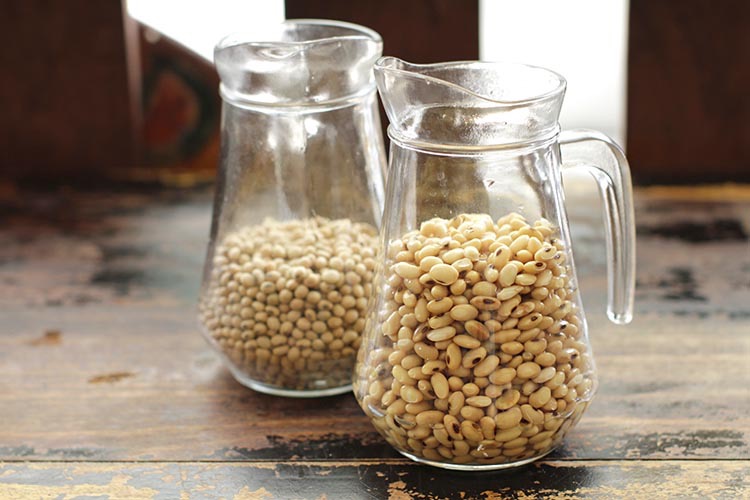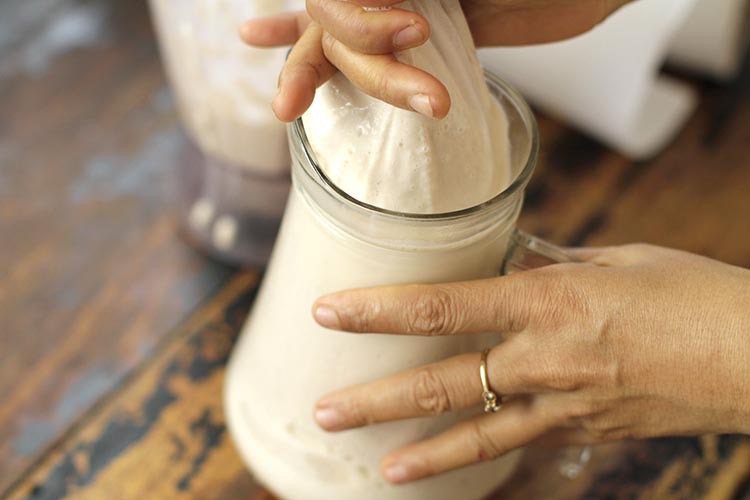
Soy beans have traditionally been an important part of a plant based diet. Soy products, namely tofu, contain an abundance of protein, making it a perfect ingredient for vegetarian and vegan meals. Tofu is generally believed to have been invented 2,000 years ago in China.
Students in this class learn how to make tofu beginning with soaking soy beans through the entire process to produce blocks of firm tofu. Freshly made tofu has a distinctly superior texture compared to mass produced tofu, making it an important base ingredient in a Thai vegetarian kitchen.
Taught in Bangkok and NYC
Students are introduced to each other and allowed a few minutes to get acquainted.
Instructor provides a brief overview of the entire process for making tofu from raw soy beans.
Students remove pre-soaked beans (placed in water the evening before class by the instructor). Beans are rinsed and the tofu making process begins.

After initial preparation of the soy beans, students cook the beans creating the base liquid. Then students learn how to turn the base liquid into the thick paste which ultimately becomes solid tofu.
Students learn how to separate the soy milk, which is a natural byproduct of the tofu making process, from the thick paste that will become the solid tofu.

A series of repetitive steps are required to remove all possible liquid from the solid base that now is beginning to form as tofu. Compression is applied to the solid base wrapped in cheesecloth in cycles designed to remove as much excess liquid as possible.
An additional drying step follows the compression steps, and students begin to shape the tofu and form the rough final blocks.

The rough tofu blocks are placed under pressure again, partly flattening the tofu into round blocks. The blocks are then cut as squares, completing the final creation. The blocks are then ready to use in Thai vegetarian and vegan recipes. Students are able to sample the tofu at this time and will immediately notice the distinct difference of the freshly made tofu to store bought mass produced versions.

There are an endless numbers of recipes that benefit from the unique taste and texture of freshly made tofu. Students are introduced to cooking concepts using freshly made tofu by learning the following recipes.

Soybeans are a type of legume that are native to East Asia but are now widely cultivated in many parts of the world, including the United States, Brazil, and Argentina. Soybeans are an important crop because they are a rich source of protein and oil, and are used in a variety of food products such as tofu, soy milk, and soy sauce. In Thailand tofu has actually only been popular since the past century, but is now commonly used in a number of dishes.
Soybeans are usually grown as an annual crop, meaning they are planted and harvested within a single growing season. They are typically planted in the spring and grow best in warm weather with plenty of sunlight. Soybean plants prefer well-drained soil that is rich in nutrients and has a pH between 6.0 and 6.8.
The process of growing soybeans starts with seed selection and preparation. Farmers will typically choose seeds that are adapted to their specific growing conditions and have been treated to prevent disease and pests. The seeds are then planted using a variety of methods, including drills and planters, and are often spaced around 2-4 inches apart.
Once the soybean plants have germinated and begun to grow, they require regular maintenance to ensure healthy development. This includes practices such as fertilization, weed control, and pest management. Many farmers will also use irrigation systems to ensure adequate water supply throughout the growing season.
Soybeans are typically harvested in the fall once the plants have matured and the pods have turned yellow or brown. The harvesting process involves cutting or pulling up the plants and removing the pods using a combine harvester. The pods are then processed to remove the soybeans, which are often dried and stored for later use or sold to buyers.
The soybean plant (Glycine max) is a member of the Fabaceae family, which also includes other legumes such as peas, beans, and lentils. The plant can grow up to 3 feet tall and has a bushy, branching structure with leaves that are trifoliate, meaning they are composed of three leaflets.
Soybean flowers are small and typically self-pollinating, meaning they do not require insects or other animals to transfer pollen between plants. The flowers give rise to pods that contain 2-4 seeds each. The seeds are typically oval-shaped and vary in color from yellow to brown, depending on the variety.
Soybeans are a rich source of protein, containing around 35-40% protein by weight. They also contain a variety of other nutrients, including fiber, vitamins, and minerals. The oil extracted from soybeans is commonly used for cooking and as a component in many food products.